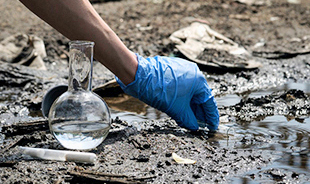Wastewater and sludge analysis

- NN 66/19; Water Act
- NN 26/2020; Ordinance on limit values for wastewater emissions
- NN 3/2020; Ordinance on special conditions for performing the activities of sampling and testing of water
- Resolution on fulfillment of special conditions for performing the activity of sampling and testing of wastewater CLASS: UP / I-325-07 / 20-02 / 01.
Wastewater is water that has been used in a process where its quality has been degraded, which is why it can no longer be reused or released into the environment before proper treatment.
Sampling wastewater
Our laboratory is authorized by the Ministry of Environmental Protection and Energy to perform wastewater sampling activities.
We analyze following parameters in wastewater:
- pH value
- Temperature
- Color
- Smell
- Sedimentary substances
- Suspended substance
- BPK5
- KPKCr
- Total organic carbon (TOC)
- Adsorbable organic halogens (AOX)
- Phenols
- Detergents, anionic
- Detergents, nonionic
- Detergents, cationic
- Arsenic - Graphite technique
- Copper - Graphite technique
- Barium
- Bor
- Zinc - Graphite technique
- Cadmium - Graphite technique
- Cobalt - Graphite technique
- Total chrome - Graphite technique
- Chrome (VI)
- Manganese - Graphite technique
- Nickel - Graphite technique
- Lead - Graphite technique
- Silver
- Iron - Graphite technique
- Mercury - DMA
- Fluorides dissolved
- Sulfites
- Sulphides dissolved
- Sulfates
- Chlorides
- Total phosphorus
- Orthophosphorus
- Chlorine free
- Chlorine total
- Total nitrogen
- Ammonium nitrogen
- Nitrites
- Nitrates
- Cyanides free
- Silicon - total silicate
- Electrical conductivity
- TDS - total solute
- Salinity
- Dissolved oxygen
- Ozone
- Dry residue at 105˚C
- Visible waste material
- Dry residue annealed at 550 ˚C
- Suspended annealed substance 550 ˚C
Sludge
- NN 178/204; Waste Act
- NN 94/2013, 73/17t, 14/19, 98/19; Law on Sustainable Waste Management
- NN 38/2008; Ordinance on sludge management from wastewater treatment plants
- NN71 / 2019; Ordinance on the protection of agricultural land from pollution
- NN 94/13 Ordinance on by-products and revocation of waste status
Industrial wastewater, such as food waste from the food industry, is biodegradable and can be mixed with domestic wastewater. Sludge from municipal wastewater is not worthless waste.
According to the Law on Sustainable Waste Management, waste sludge belongs to special categories of waste, and management of wastewater from wastewater treatment plants is prescribed by the Minister with an ordinance in cooperation with the Minister responsible for water management.
The Ordinance on sludge management from wastewater treatment plants (NN 38/2008) was created on the basis of the Waste Act, and was drafted for the use of sludge for agricultural purposes. In order to prevent harmful effects on soil, plants, animals and humans, sludge must be used in an adequate way so that the nutrient needs of plants are taken into account, the quality of the soil is preserved, and the quality of surface and groundwater is preserved.
We analyze sludge for following parameters:
- dry matter content
- pH value (pH CaCl2 and pH H2O),
- total nitrogen,
- total phosphorus,
- organic matter or organic carbon,
- carbonate content,
- proportion of active lime,
- element content: K, Ca, Mg, Fe, Zn, Cu, Mn, Mo, Na,
- content of heavy metals in dry matter: As, Cd, Ni, Pb, Cr, Mo, Co, Hg

